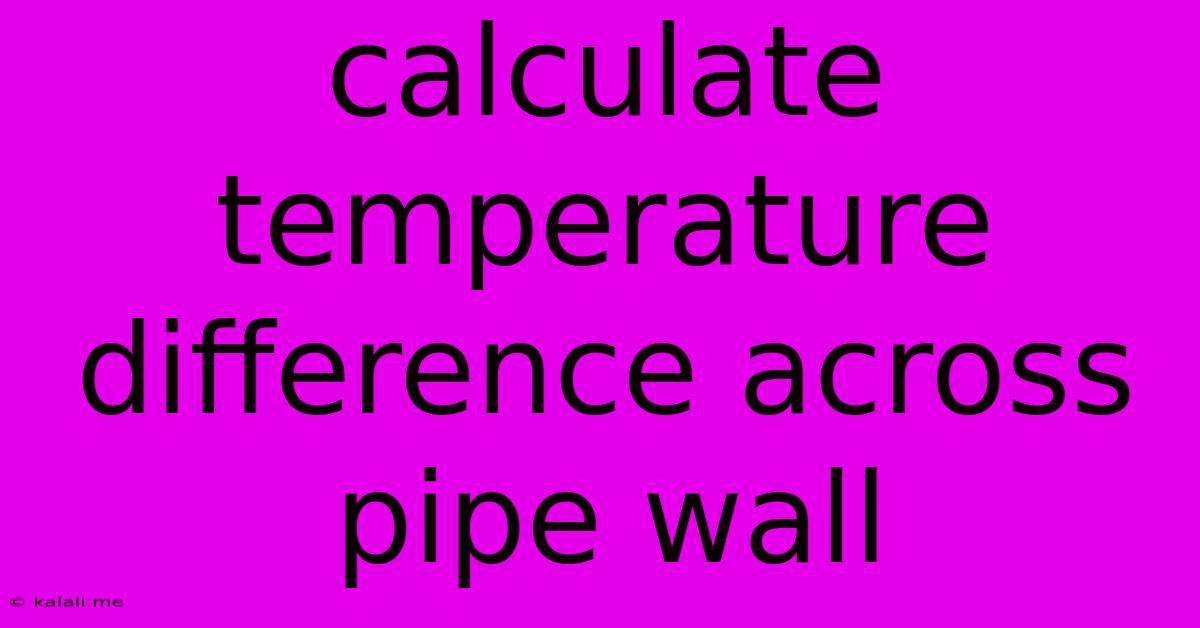Calculate Temperature Difference Across Pipe Wall
Kalali
Jun 01, 2025 · 3 min read

Table of Contents
Calculating Temperature Difference Across a Pipe Wall: A Comprehensive Guide
Calculating the temperature difference across a pipe wall is crucial in various engineering applications, from designing efficient heating systems to analyzing heat transfer in chemical processes. Understanding this calculation helps engineers predict heat loss, optimize insulation, and ensure the structural integrity of piping systems. This article will guide you through the process, explaining the underlying principles and providing practical examples.
Understanding Heat Transfer Mechanisms
Before delving into the calculations, it's essential to understand the primary mechanism involved: conduction. Heat transfer through the pipe wall occurs via conduction, where heat energy is transferred from a region of higher temperature to a region of lower temperature within a material. The rate of heat conduction is governed by several factors, including the material's thermal conductivity, the temperature difference, and the geometry of the pipe.
Key Variables and the Formula
To calculate the temperature difference across the pipe wall, we'll use Fourier's Law of Heat Conduction. This law states that the rate of heat transfer (Q) through a material is proportional to the area (A) and the temperature gradient (ΔT/Δx), and inversely proportional to the thickness (Δx) of the material. For a cylindrical pipe, the formula becomes slightly more complex:
Q = (2πLk(T₁ - T₂)) / ln(r₂/r₁)
Where:
- Q = Rate of heat transfer (Watts)
- L = Length of the pipe section (meters)
- k = Thermal conductivity of the pipe material (Watts per meter-Kelvin)
- T₁ = Temperature of the inner surface of the pipe (Kelvin)
- T₂ = Temperature of the outer surface of the pipe (Kelvin)
- r₁ = Inner radius of the pipe (meters)
- r₂ = Outer radius of the pipe (meters)
- ln = Natural logarithm
Step-by-Step Calculation Process:
-
Gather your data: You'll need the pipe's dimensions (length, inner and outer radii), the thermal conductivity of the pipe material (easily found in engineering handbooks or online resources), and the temperatures at both the inner and outer surfaces. Ensure consistent units throughout your calculations.
-
Convert temperatures to Kelvin: Remember to convert Celsius or Fahrenheit temperatures to Kelvin using the appropriate conversion formulas. This is crucial for accurate results.
-
Apply the formula: Substitute the values into the formula above and calculate the rate of heat transfer (Q).
-
Determine the temperature difference: If you know the heat transfer rate (Q) and other parameters, you can rearrange the formula to find the temperature difference (T₁ - T₂).
Example Calculation:
Let's say we have a steel pipe with the following properties:
- Length (L) = 10 meters
- Inner radius (r₁) = 0.05 meters
- Outer radius (r₂) = 0.06 meters
- Thermal conductivity of steel (k) = 50 W/m·K
- Inner surface temperature (T₁) = 100°C (373.15 K)
- Outer surface temperature (T₂) = 80°C (353.15 K)
Using the formula, we can calculate the heat transfer rate:
Q = (2π * 10 m * 50 W/m·K * (373.15 K - 353.15 K)) / ln(0.06 m / 0.05 m) ≈ 61573 Watts
This calculation reveals a significant heat loss from the pipe.
Factors Influencing Temperature Difference:
Several factors can influence the temperature difference across a pipe wall, including:
- Material properties: Different materials have different thermal conductivities, significantly impacting heat transfer.
- Pipe dimensions: Thicker pipes generally have a larger temperature difference.
- Fluid flow: The velocity and properties of the fluid inside the pipe can affect the inner surface temperature.
- Insulation: Adding insulation increases the effective pipe radius (r₂) and reduces the temperature difference.
Conclusion:
Calculating the temperature difference across a pipe wall is essential for engineers to design, analyze, and optimize piping systems. Understanding the principles of heat conduction and applying Fourier's Law correctly ensures accurate results. By considering the various factors influencing heat transfer, engineers can create more efficient and reliable systems. Remember to always double-check your units and utilize reliable sources for material properties.
Latest Posts
Latest Posts
-
Why Doesnt Regression Work With Multicollinear Variables
Jun 03, 2025
-
Can You End A Paragraph With A Question
Jun 03, 2025
-
How To Clean A Moldy Fridge
Jun 03, 2025
-
Sql Copy Table From One Database To Another
Jun 03, 2025
-
What Do You Call A Person Who Easily Finds Flaws
Jun 03, 2025
Related Post
Thank you for visiting our website which covers about Calculate Temperature Difference Across Pipe Wall . We hope the information provided has been useful to you. Feel free to contact us if you have any questions or need further assistance. See you next time and don't miss to bookmark.